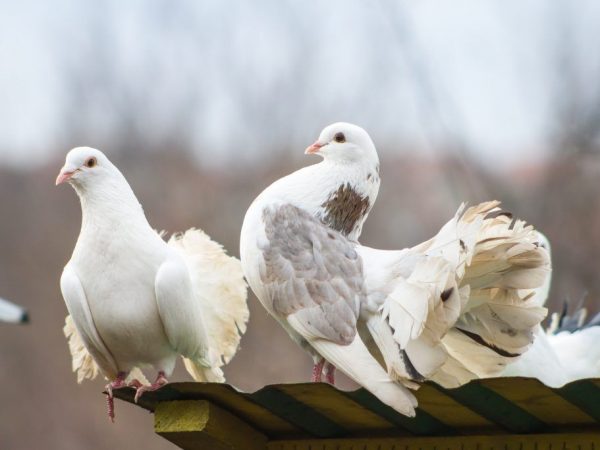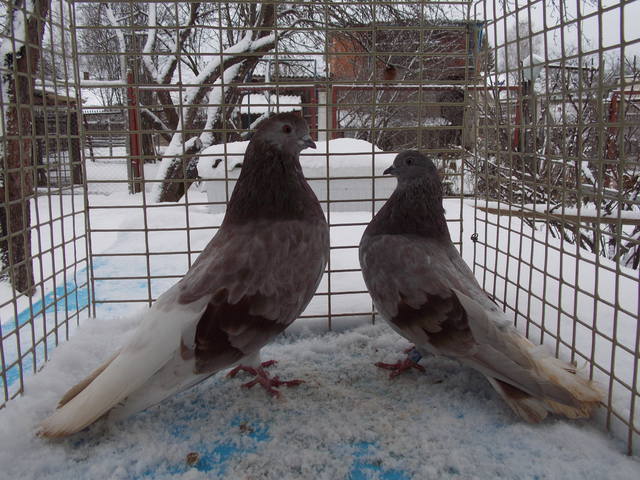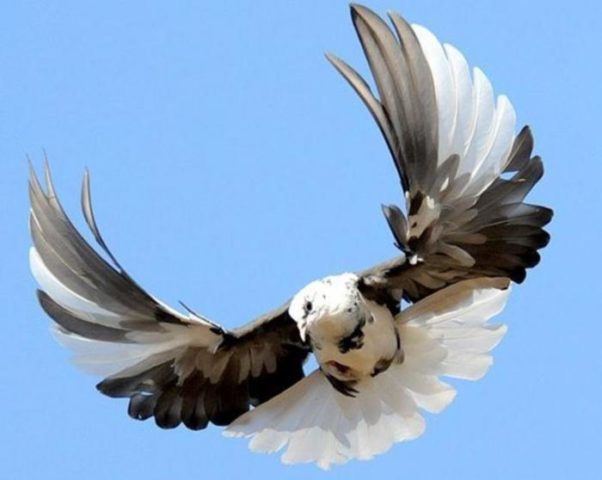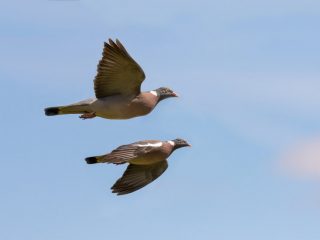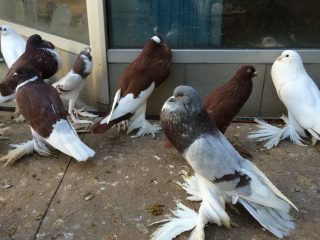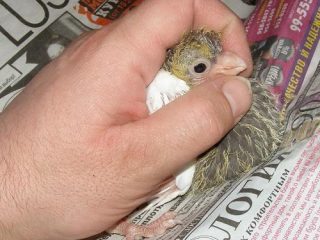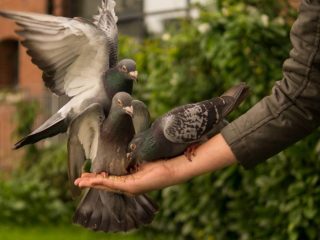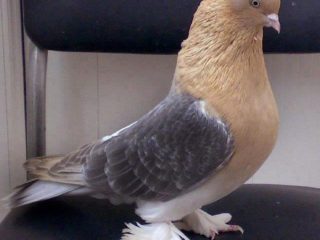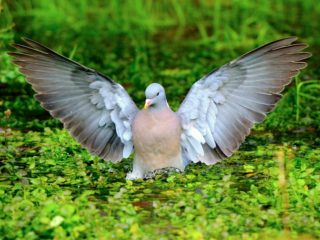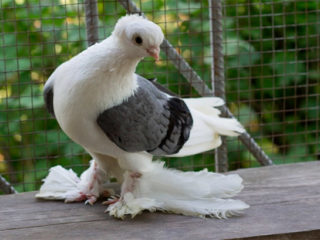Content
In Vladimir Menshov’s film “Love and Doves” the theme of love is revealed from a curious side, in which birds play an important role, being a symbol of this feeling.
Izhevsk pigeons are the standard of feelings of fidelity and love. This breed is one of the few whose representatives do not move away from the dovecote to the side, but rise up to such a height that they are practically invisible. Up close, these birds are beautiful and graceful.
History of the Izhevsk breed of pigeons
The history of the appearance of this breed is amazing. Pigeons were domesticated by people 5 thousand years ago and served as a means of communication. But this is not the only thing that attracted people to pigeons. The man admired the beauty and grace of the body of this bird, the beauty of its flight and the pleasant purring when communicating.
Izhevsk pigeons are similar to their closest relatives - Perm pigeons.
It is believed that the breed appeared 100 years ago, but there is information that the pigeons themselves were brought to Izhevsk at the beginning of the 19th century, when, on the orders of the Tsar, an arms factory was built, and craftsmen were brought from Tula to work on it. So they brought pigeons along with their property, probably in order to maintain correspondence with the relatives who remained in Tula.
How many years it took for selection, and what breeds were used, one can only guess, but it is unlikely that it took a hundred years.From the stories of Izhevsk pigeon breeders it is known that in the city there are other names for this breed - Tikhonovsky, Matveevsky, Aleksandrovsky, after the names of local breeders. There were even Povarskys, in memory of the fact that among the participants in the creation of this breed there was a person by profession as a cook.
This is how the Izhevsk pigeon breed appeared, the main advantage of which is the amazing ability to fly at an unattainable height.
Flight characteristics
The flight of Izhevsk pigeons is mesmerizing. Being large in size, they fly to such a height that they are difficult to see from the ground. The flock circles at an unimaginable height, but does not fly away from home over long distances.
The flock spends more than 2 hours in the sky, and in flight - up to 15 hours. To maintain the ability to fly, pigeons must be allowed to rest for 2-3 days after the flight. You also need a high-calorie diet.
Izhevsk pigeons are released into flight every day for 5-6 hours. The weather should be dry and windless. There is a risk that in a strong wind the flock will be scattered, and some of the pigeons will get lost or even die. If a pigeon strays from the flock, it may not return.
If the dovecote is equipped with lighting from the outside, then the birds can be released in the dark.
To enjoy the flight of Izhevsk pigeons, they are trained. They start cooking from a young age. Otherwise, the bird will sit too long, and its flight qualities will deteriorate or disappear. The training is carried out in several stages:
- The pigeons meet the person who will train them. The trainer enters the dovecote at the same time every day. You need to take the same clothes, always clean. The pigeons gradually get used to it and begin to show their attitude towards the trainer, sit on him, and eat from his hands.The trainer studies all the young animals.Attention! Smell is important to pigeons. It is better if the clothes are used only for meeting them.
- After 40 days, the young animals begin to learn to fly from the nursery to the enclosure. If it suddenly turns out that they are weak for such a procedure, it is postponed for a couple of weeks. When classes resume, they will be held for 5 days. During this time, they find out the behavior in the pack, whether there are pronounced loners, what they are afraid of and how they react to other people and animals.
- Pigeons are released onto the roof. Here the pigeons get used to the free space. This lasts 5 days, after which they begin flying. Birds do not fly far and return quickly. The coach must understand how they feel in flight, at altitude, and how they find their way home. A leader is selected from among experienced birds, and the young birds are released with him into flight - with a flock and one at a time. It takes a week for the young pigeons to master flight techniques and begin to imitate the leader. When the flight duration increases by more than 40 minutes, young pigeons are combined with the main flock.
- The training is completed when the young bird begins to lose its flight feathers and it is time to molt. At this time, the birds are not released. Pigeons that are sick or overworked and females preparing to produce offspring are also not trained.
A sign that a bird is well trained is when it rises to a height.
Breed characteristics and standards
When breeding the Izhevsk breed, the Perm was used. The resulting result is good: the individual is muscular, strong, with smooth plumage and at the same time intelligent. Flying in the sky-high distances, he perfectly understands where he is and unmistakably identifies home.
In pigeon breeding, the issue of purity of blood of any breed is fundamentally important. For Izhevsk pigeons, there are strict parameters by which they are recognized as purebred:
- muscular and powerful chest;
- body length up to 35 cm;
- when taking a stance, the body is slightly tilted;
- the length of the wing should almost reach the rectangular tail;
- small round head in males and elongated in females;
- there is no feathering on the short legs;
- the body has smooth plumage;
- beak is small, chicken-colored;
- the eyes are slightly bulging and black.
The main characteristic feature of the thoroughbred Izhevsk pigeon is the shape of the head, which distinguishes the sex of the bird.
Minor deviations when determining purebredness are a slight excess in the size of the body, small feathering of the legs, a slightly reduced sternum, a very small beak and slight brown eyes.
Purebred is not recognized if the individual is very large, with small wings, an underdeveloped sternum, elongated legs with feathers, blue-gray eyes and ruffled feathers.
Purebred Izhevsk pigeons are beautiful and cheerful, smart and athletic.
Breeding Izhevsk pigeons
Breeding Izhevsk pigeons is not difficult; for this you need to have a well-built, dry and warm dovecote. Maintain cleanliness and remove bird excrement. Change the bedding, prepare the dovecote for winter, sealing cracks and holes so that there is no draft, which is contraindicated for birds.
Pigeon feeding
Izhevsk pigeons are fed twice a day immediately after flights. The food must contain the necessary set of nutrients and vitamins; you cannot overfeed. The most acceptable food is cereals.
An adult Izhevsk pigeon needs up to 85 g of grain every day. In winter, they feed with oats - 20 g and barley - 65 g. Lentils and corn grits are also used. Feeding bread and porridge is not allowed, as this leads to illness. When fed, flax and rapeseed improve plumage. Pigeons of the Izhevsk breed love to swim in the heat.
The norm of life for Izhevsk high-flying pigeons is rest and sitting in a nest or on a perch inside a dovecote. They only fly out to drink and eat. Pigeons are not allowed to walk on the ground or roof, especially for young pigeons. Their element is high flights and rest before the next soar into the sky.
Diseases and treatment of birds
Purebred birds get sick, just like others. Most often they develop infectious diseases and parasites. The reasons for this are irregular cleaning of the poultry house, dampness and drafts.
The main diseases are smallpox, salmonellosis and whirlwind (Newcastle disease). For preventive purposes, birds are vaccinated.
The entire flock is vaccinated at once.
Before starting vaccinations, the diet is reviewed. Izhevsk pigeons are fed grain rich in protein, minerals and vitamins. Only healthy individuals should be vaccinated.
People are vaccinated against smallpox in those regions where the disease is common. It is better to do this in a veterinary hospital. The vaccine is valid for a year.Vaccine against salmonellosis twice a year. To prevent whirligigs, Izhevsk residents are vaccinated with the drug Avivak.
If vaccinations are not done, and a sick individual is discovered, it is removed and isolated from others. It is not difficult to identify a sick pigeon during a daily examination: it changes behavior, does not eat, hides, feathers lose their smoothness and become ruffled. The droppings of such a bird are liquid, and discharge appears from the beak and eyes.
A sick individual is not vaccinated, this procedure will kill it, but it is possible to treat and cure it.
Pigeon fanciers successfully treat the pigeon bird at home; the main thing here is to correctly diagnose the disease and in the first 10 days the sick bird can be cured.
For treatment, the drug is used in Fosprenil capsules. It is effective, has no side effects and is not dangerous to birds. It is injected intramuscularly into the sternum or given to the pigeon through the beak.
But it is preferable to show a sick pigeon to a veterinarian.
In order for birds to get sick less, they need a balanced diet, enhanced with a vitamin complex.
Conclusion
Izhevsk pigeons are good in all respects and deservedly enjoy success among pigeon breeders. They have excellent flight qualities, are unpretentious and hardy. These birds are made for the sky. The feeling of love for them comes not only during breathtaking flights, but also from communicating with them.
